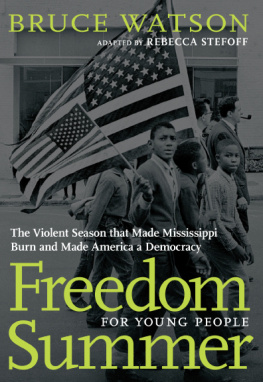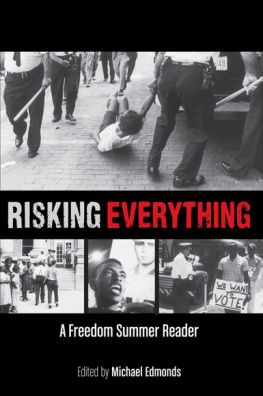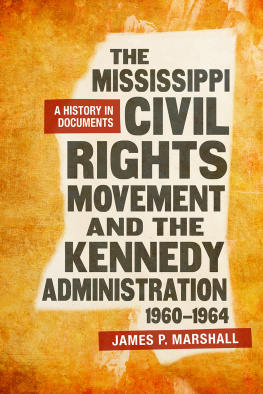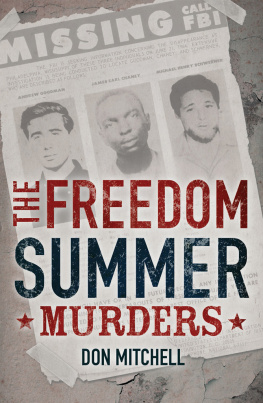Thunder of Freedom
THUNDER
OF
FREEDOM
Black Leadership
and the
Transformation of
1960s Mississippi
Sue [Lorenzi] Sojourner with Cheryl Reitan
Photographs by Sue [Lorenzi] Sojourner
Foreword by John Dittmer
Copyright 2013 by Susan Hasalo Sojourner and Cheryl Riana Reitan
The University Press of Kentucky
Scholarly publisher for the Commonwealth,
serving Bellarmine University, Berea College, Centre College of Kentucky, Eastern
Kentucky University, The Filson Historical Society, Georgetown College, Kentucky
Historical Society, Kentucky State University, Morehead State University, Murray
State University, Northern Kentucky University, Transylvania University,
University of Kentucky, University of Louisville, and Western Kentucky University.
All rights reserved.
Editorial and Sales Offices: The University Press of Kentucky
663 South Limestone Street, Lexington, Kentucky 40508-4008
www.kentuckypress.com
17 16 15 14 13 5 4 3 2 1
Cataloging-in-Publication data is available from the Library of Congress.
ISBN 978-0-8131-4093-3 (hardcover : alk. paper)
ISBN 978-0-8131-4094-0 (epub)
ISBN 978-0-8131-4095-7 (pdf)
This book is printed on acid-free paper meeting the requirements of the American
National Standard for Permanence in Paper for Printed Library Materials.

Manufactured in the United States of America.

Member of the Association of American University Presses
The images of Ozell Mitchell on the cover and on page 25, Ralthus Hayes on page 37, older Mileston women on page 68, and the Freedom Democratic Party Office on page 158 were published in Minds Stayed on Freedom: The Civil Rights Struggle in the Rural SouthAn Oral History by Youth of the Rural, Organizing, and Cultural Center (Boulder, CO: Westview Press, 1991).
To the Holmes movement community
and its leaders,
to Henry, to Demitri Shimkin,
and to my family.
Contents
Their Stories: Sam and Laura Redmond
Their Stories: Ralthus Hayes; John Daniel Wesley
Their Stories: Shadrach Crook Davis; Norman and Rosebud Clark
Their Stories: Reverend Jesse James Russell
Their Stories: Alma Mitchell Carnegie
Their Stories: Kids Racing the Bug Sprayer
Their Stories: McGees Caf
Their Stories: Rosie Heads Birthday Party; Reverend Joseph McChriston
Their Stories: Mr. and Mrs. Burrell Tate
Their Stories: Eugene Montgomery; A Group Gathers for a Countywide Meeting
Their Stories: Five People Comment about Henry Lorenzi
Their Stories: Movement Visitors to the Balance Due House
Their Stories: Robert G. Clark: The Day Is Coming
Their Stories: Edgar Love and the Tchula Shootout; Alec Shimkins Reflection
Their Stories: Mary Lee Hightower; Robert G. Clark, at a Farmers Co-op Meeting; A Late-Night Meeting with Robert G. Clark
Photographs
Foreword
Sue and Henry Lorenzi first set foot in Mississippi in September of 1964. Earlier that summer nearly a thousand volunteers, most of them white college students, came down to work with local people and full-time civil rights activists in projects throughout the state. They staffed the community centers, taught in the new freedom schools, and helped organize the Freedom Democratic Party, which challenged the states white-supremacist delegation at the Democrats national convention in Atlantic City. The attention of the world had focused on Mississippi that summer after the disappearance of the three civil rights workers in Neshoba County. When, nearly three months later, the bodies of James Chaney, Michael Schwerner, and Andrew Goodman were found buried under a dam, the states reputation as the most violent and repressive in the nation was confirmed.
Nonetheless, Freedom Summer (as it came to be known) changed Mississippi. The summer project and the attendant national publicity, grudging compliance with the new Civil Rights Act, and the peaceful desegregation of a handful of public schools in the fall of 1964 marked the beginning of the end of the politics of massive resistance in the Magnolia State. Racism remained entrenched in the white community, and for a time a revived Ku Klux Klan ran wild in parts of the state. But by holding firm and refusing to back down in the face of intimidation and terror, movement activists had won the right to organize their communities, a major achievement in its own right.
It was by chanceand good fortunethat the Lorenzis ended up in Holmes County. Located about seventy miles north of the state capital in Jackson, Holmes is mostly rolling hill country. Its western sector, however, is rich Delta farmland, and there in the early 1940s a group of black sharecroppers purchased farms as part of the New Deals Farm Security Administration program. Assisted by field secretaries from the Student Nonviolent Coordinating Committee (SNCC), these independent farmers founded their own movement in the early 1960s. When the Lorenzis first arrived in Holmes, they met Hartman Turnbow and Ralthus Hayes, leaders of a group of fourteen Holmes County blacks who had defied custom and risked arrest by attempting to register to vote in the spring of 1963. As Lawrence Guyot has observed, no local movement in the state was as broad based, indigenous, or contagious as in Holmes. The Mississippi Freedom Democratic Party achieved its greatest successes there, winning its first major victory in 1967 when a Holmes County schoolteacher named Robert Clark became the first African American elected to the Mississippi legislature in the twentieth century.
I first met Susan Sojourner in the late 1980s at her home in Washington, D.C. I was then doing research for my book on the Mississippi movement and had learned from several people that Sojourner had collected some primary source material relating to the movement in Holmes County. After we exchanged pleasantries, Sue escorted me to her basement, which was filled with file cabinets stuffed with documents and reel-to-reel tapes of interviews she had conducted in the late 1960s with local people active in the struggle. In short, it was a gold mine. I realized then that if I had been starting over, I could settle in with this wealth of material and write a book about what was politically the most interesting county in black Mississippi. But I was not starting over, and besides, the logical person to chronicle the Holmes County story was sitting next to me. I told Sue Sojourner that this was the book she was meant to write.
She had also taken hundreds of striking photographs, and after she moved to Duluth she mounted a photographic exhibit, The Some People of That Place: Holmes County, Mississippi, which appeared in selected cities to great popular and critical acclaim. (Photographs from that exhibit are included in this book. Judge for yourself!) Sue took her exhibit to Holmes County so that the people who made that movement could see themselves in action. They responded enthusiastically and, as they had in the 1960s, encouraged their friend to write more about that time as well. Sue insisted that the story should focus almost entirely on the local people, not on outside agitators like her and Henry. Finally, at the urging of several of us, including Constance Curry, another movement activist who has written widely and well about the freedom struggle, Sue agreed to tell her story as well. In the latter stages of her work, Cheryl Reitan contributed her considerable talents as a writer and editor. The result is this book.










 Member of the Association of American University Presses
Member of the Association of American University Presses